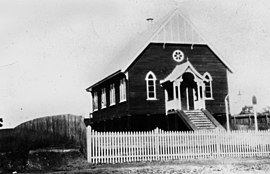
Milton is a riverside inner suburb of the City of Brisbane, Queensland, Australia. In the 2021 census, Milton had a population of 3,144 people.

Alderley is a northern suburb in the City of Brisbane, Queensland, Australia. In the 2021 census, Alderley had a population of 6,748 people.

Mitchelton is a north-western suburb in the City of Brisbane, Queensland, Australia. In the 2021 census, Mitchelton had a population of 9,244 people.

Clayfield is a suburb in the City of Brisbane, Queensland, Australia. In the 2021 census, Clayfield had a population of 10,897 people.

Taringa is a suburb in the City of Brisbane, Queensland, Australia. In the 2021 census, Taringa had a population of 8,732 people.

Ashgrove is a suburb in the City of Brisbane, Queensland, Australia. In the 2021 census, Ashgrove had a population of 13,450 people.

Bardon is a western suburb of the City of Brisbane, Queensland, Australia. It is located approximately 5.7 kilometres (3.5 mi) north-west of the Brisbane CBD. Bardon is a leafy residential suburb, much of which nestles into the foothills of Mount Coot-tha. It includes the neighbourhood of Rainworth. In the 2021 census, Bardon had a population of 10,153 people.

Middle Park is a residential south-western suburb in the Centenary Suburbs in the City of Brisbane, Queensland, Australia. In the 2021 census, Middle Park had a population of 3,845 people.

Chelmer is a south-western suburb in the City of Brisbane, Queensland, Australia. In the 2021 census, Chelmer had a population of 3,325 people.

Corinda is a suburb in the City of Brisbane, Queensland, Australia. In the 2021 census, Corinda had a population of 5,555 people.

Keperra is a suburb in the City of Brisbane, Queensland, Australia. In the 2021 census, Keperra had a population of 7,014 people.

East Brisbane is an inner southern suburb of the City of Brisbane, Queensland, Australia. In the 2021 census, East Brisbane had a population of 6,186 people.
Newmarket is a north-west suburb in the City of Brisbane, Queensland, Australia. In the 2021 census, Newmarket had a population of 5,083 people.

Red Hill is an inner northern suburb in the City of Brisbane, Queensland, Australia. In the 2021 census, Red Hill had a population of 5,834 people.

Graceville is a suburb in the City of Brisbane, Queensland, Australia. In the 2021 census, Graceville had a population of 4,764 people.

Everton Park is a northern suburb of the City of Brisbane, Queensland, Australia. In the 2021 census, Everton Park had a population of 10,111 people.

Enoggera is a north-western suburb in the City of Brisbane, Queensland, Australia. It is home to the Gallipoli Barracks.

Sherwood is a suburb in the City of Brisbane, Queensland, Australia. In the 2021 census, Sherwood had a population of 6,082 people.

North Ipswich is a suburb of Ipswich in the City of Ipswich, Queensland, Australia. In the 2016 census, North Ipswich had a population of 4,515 people.

Dinmore is a suburb of Ipswich in the City of Ipswich, Queensland, Australia. In the 2016 census, Dinmore had a population of 875 people with an unemployment rate of 16.7%, in comparison to the Australian unemployment rate of 6.9%.





















